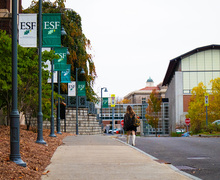Moran: When visiting a Muslim country, be respectful of cultural norms
Before this semester, I had only been outside of the United States once, to go to the Canadian side of Niagara Falls. Therefore, when I traveled to Malaysia this past weekend, it was my first time visiting a country with a significant Muslim population.
According to the country’s Islamic Tourism Center, 60 percent of the population is Muslim. The constitution names Islam as the official religion, but citizens are offered the “freedom to practice other religions.”
When packing for the trip, I was really nervous and confused about what clothes I should bring. I wanted to be respectful of local customs, but the temperatures were also in the 90s on the days that we were there, so I wanted to be comfortable. It didn’t help that I was flying alone, arriving late at night and worried about safety.
To prepare for the trip, I read many traveler forums online. I spoke with friends who had been to the country and friends who were studying in other Muslim countries. The reviews were mixed. Since I was staying in Kuala Lumpur — which, as Malaysia’s capital, is a fairly large and international city — I would be able to safely walk in the streets in shorts or thin straps. However, to be respectful of the culture, it would be better if I wore skirts that were at least knee length and shirts with three quarter length sleeves.
My solution was to pack many options. I figured that it was better to be over-prepared than underprepared.
When flying into the country, I wore the loosest, most conservative clothing that I had just to be safe. While touring the city, I mostly settled on knee-length dresses with light sweaters. I paid close to attention to the dress codes around me. I saw a huge variety. Some women wore burqas and some wore hijabs. Since we spent much of our time in touristy locations, I also saw many women in shorts and tank tops. It seemed that all my worrying prior to leaving Hong Kong was unnecessary.
On our last day in the city, we visited the Batu Caves, which is a famous set of Hindu temples and shrines inside a series of caves, and the National Mosque of Malaysia. These sites had stricter dress codes than the rest of the sites we’d visited in the big city of Kuala Lumpur. I wore my long pants and packed a scarf in case I needed to cover my head.
Our first stop was the caves. I had read that the dress code at this site wasn’t strictly enforced and it wasn’t. In certain parts of the temple, we had to take off our shoes. There were a few signs at the entrance that prohibited short skirts or shorts and there was a booth that allowed people to rent shawls to cover their legs while they were in the temple, but many people ignored these rules.
At the mosque, it was a different story. I had to cover everything except for my face, hands, and feet. At the entrance to the mosque, a woman gave me a purple robe and black head covering with rhinestones. My one male friend also had to wear a robe because he was wearing shorts, but my other male friend was allowed to enter without a robe in long pants and a short sleeve shirt. None of us were allowed to wear shoes here either.
Inside the mosque, I saw one female tourist who had removed her head covering. To me, that is the epitome of disrespect. I understand that there are a lot of people out there, including some Muslim women, who argue that the headscarf is oppressive. I also know that there are a lot of people that argue that the hijab is actually a liberating garment. Regardless of how you feel on this issue, if you as a tourist are choosing to enter a religious site, you should do so in a way that is respectful of that religion. If she didn’t want to wear the scarf, she shouldn’t have gone to the mosque.
Claire Moran is a junior broadcast and digital journalism and international relations dual major. Her column appears weekly in Pulp. She can be reached at clmoran@syr.edu.
Published on March 30, 2016 at 8:26 pm






